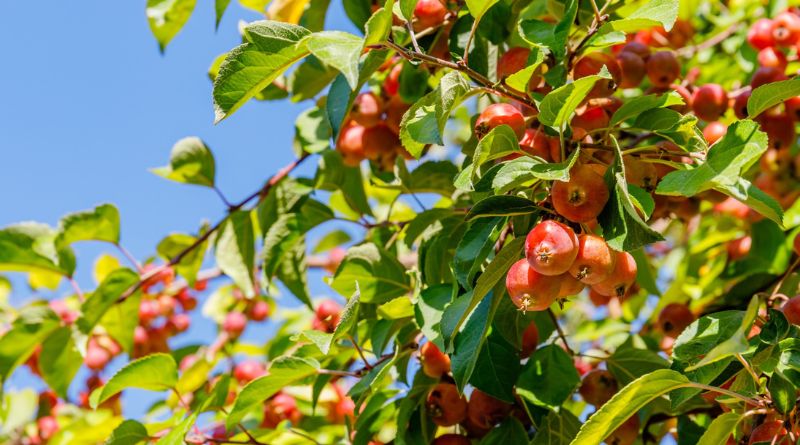Our article provides a complete description of crabapple tree fruit. The crabapple tree fruit is smaller and tarter than regular apples. They come in various colors, including yellow, amber, orange, red, and purple. Crabapples tend to have a tart taste despite their edible nature, so you wouldn’t want to eat them raw. Crabapples generally have a tarter taste than regular apples, so they are used in cooking. Crabapple tree fruit is commonly eaten in jellies, sauces, pickled crabapples, and jams. However, some crabapple tree fruit varieties are still too sour to be eaten even after they have been cooked. Crabapples of the Dolgo, Callaway, Centennial, Chestnut, Wickson, and Whitney varieties are juicy and tasty.
Types Of Crabapple Tree Fruit
Following are the types of Crabapple Tree Fruit:
European crabapple

The European Crabapple Tree Fruit is a small, thorny native wild tree found throughout most of Europe, including all Nordic countries except Iceland. Malus sylvestris, or “forest apple,” grows as single plants or small groups along forest edges, thickets, hedgerows, or roadsides. In Central Asia, this wild apple was domesticated around 3000-4000 years ago and is one of the earliest trees to be cultivated. Approximately 1500 years ago, the European crab apple contributed genes to the domesticated apple. Consequently, domestic apples are now more closely related to crab apples than to Malus sieversii.
For More- What Does Lamb Taste Like?
Red Jewel Crabapple
The Red Jewel Flowering Crabapple is covered in stunning clusters of fragrant white flowers in mid-spring, which appears from shell-pink flower buds before the leaves emerge. From early fall to late winter, cherries’ redpomes are abundant. Dark green leaves cover the tree for most of the year. Yellow leaves appear in the fall. When mature, this crabapple will reach a height of 18 feet and a width of 12 feet. This plant has a low canopy with a typical clearance of 3 feet from the ground; it can be planted under power lines. Under ideal conditions, it can live for 50 years or more. It grows at a medium rate.
Siberian crabapple
The Siberian Crabapple is a deciduous types of Crabapple trees with a rounded canopy of spreading branches, eventually reaching 20 to 25 feet among several flowering crabapples. In bud, the single, 1.5-inch-diameter flowers are pink but open white. After blooming, the plant produces long-lasting, bright red or yellow fruits popular with birds and made into jelly. Unfortunately, the fruit of crabapples often falls on lawns, walkways, and driveways, causing havoc.
Royal Raindrops Apple

The Royal Raindrops flowering crabapple is a newer cultivar with bold, pinkish-red blossoms in spring. The blooms are followed by tiny, reddish-purple fruits that provide food for birds well into winter. The dark green leaves turn a coppery red in autumn. Water Royal Raindrops regularly during the first few years to establish a healthy root system; after that, occasional deep watering is sufficient. However, beware of watering excessively, which may cause root rot.
Robinson Crabapple
The Robinson crabapple has a beautiful color that everyone loves. This tree has huge, soft pink blooms in the spring, decorative fruit in the fall, and textured bark. In addition, the new Robinson Crabapple resists many diseases and pest problems that some of the older varieties of crabapples were plagued by. Crabapples from Robinson are a big hit because they’re so unique. Growing up to 15-20 feet tall, they still catch the eye. In addition to looking good, they’re also very easy to grow. Beginners may feel like they are master gardeners after tending to them. Robinson crabapples are one of our most popular flowering trees, so be sure to order one now while they are in stock.
Dolgo Crabapple Tree Fruit
It is a beautiful crabapple tree with good cold tolerance and disease resistance. The tree is covered with white flowers in spring, which appears before it has even begun to form leaves. With the long bloom time of its flowers, it makes a good pollinator for other types of crabapple and apple trees. In August and September, the Dolgo Crabapple produces large, crimson Crabapple Tree Fruit that is delicious and fragrant. This tree makes an excellent deer hunting tree because of the crabapple fruit’s size, color, and flavor.
How to propagate Dolgo Crabapple Trees?
If you have a sunny area in your yard, you might want to plant Dolgo Crabapple Tree Fruit. You can propagate your crabapple from seeds or cuttings of an existing healthy tree. The crabapple produces numerous shoots and suckers that are easy to propagate, and if you are patient and have time, you can even grow it from seeds. In the spring, they are stunning, covered with lovely blossoms, and in the fall, they produce a heavy crop of tasty, trim apples.
How Fast do Dolgo Crabapple Trees Grow?

Crabapple trees are our popular ornamental trees because of their easy maintenance and visual appeal throughout the seasons. Native plants of North America bloom in April or May and produce small colored fruits in the fall and winter. It grows between 20-30 feet tall and 15-20 feet wide at maturity, with an upright growth habit. However, the plant can be maintained to a smaller size, so picking the fruit is easier! The tree grows between 1-2 feet in height per year, with a moderate to fast growth rate.
Also Read- Donut Types: You Must Try These Flavors!
Bottom Line
Crabapple trees require little maintenance. To keep the soil moist after planting a young crabapple, you will need to water it frequently. After the tree is established, however, it becomes more tolerant of drought, so you don’t need to water it as much.
My article on crabapple tree fruit is hoped to be useful to you.
FAQs
Dolgo Crabapple trees are known for their moderate to fast growth rate. On average, they can grow between 12 to 24 inches per year, depending on various factors such as soil quality, sunlight, and water availability.
Several factors can influence the growth rate of Dolgo Crabapple trees, including soil conditions, sunlight exposure, water availability, and overall care. Providing optimal conditions, such as well-drained soil and adequate sunlight, can enhance their growth.
The best time to plant Dolgo Crabapple trees is during the dormant season in late fall to early spring. This allows the tree to establish its roots before the growing season, promoting healthier and faster growth.







